Measure when an ad click or view leads to a conversion, such as a purchase on an advertiser site.
Who is this for?
Here you'll find the basics of Attribution Reporting and some underlying concepts, but not much technical detail.
- If you work in advertising or ad tech, you'll learn about how this API provides capabilities that are enabled by third-party cookies. Check out the API use cases, which have more detail of how the reports are generated.
- If you're a developer or software engineer, head over to the full system overview or experiment and participate with the API.
Advertisers and publishers that rely on ad tech platforms for conversion measurement don't need to use the API directly. You may be interested in understanding how Attribution Reporting works if your ad tech plans to integrate with this API.
What is the Attribution Reporting API?
Today, ad conversion measurement often relies on third-party cookies. Browsers are restricting access to third-party cookies because these can be used to track users across sites and hinder user privacy.
The Attribution Reporting API enables those measurements in a privacy-preserving way, without third-party cookies.
This API enables advertisers and ad tech providers to measure conversions in the following cases:
- Ad clicks and views.
- Ads in a third-party iframe, such as ads on a publisher site that uses a third-party ad tech provider.
- Ads in a first-party context, such as ads on a social network or a search engine results page, or a publisher serving their own ads.
If you're unfamiliar with some of these terms or concepts, consult the Privacy Sandbox glossary.
Try the API
- Test locally in your browser. Set a flag, which tells the Chrome browser to enable specific experimental features.
If you're interested in experimenting with the API, head over to Attribution Reporting: experiment and participate.
API changes
- Keep track of the API changes.
- Learn why we shipped the Attribution Reporting API in the first half of 2023.
Availability
| Proposal | Status |
|---|---|
| Conversion journey: app-to-web Web explainer and Android explainer Mailing list announcement |
Available in Chrome and Android for origin trial |
| Conversion journey: cross-device Explainer |
This proposal has been archived. There are no current plans for implementation. |
| Preventing invalid aggregatable reports using report verification Explainer |
This proposal has been archived. We have implemented trigger_context_id for this use case instead. |
| Default allowlist for the Attribution Reporting API Permissions-Policy will remain * Mailing list announcement |
Available in Chrome in Q1 2023 |
| Configurable event-Level reporting epsilon GitHub issue |
Available in Chrome in Q4 2023 |
| Padding for aggregatable reports payload Updated explainer |
Available in Chrome in Q4 2023 |
| Phase 1 lite flexible event-Level Flexible event-level configurations explainer |
Available in Chrome in Q4 2023
The ability to customize the number of attribution reports and the number/length of reporting windows. Available in Chrome in Q1 2024 The ability to customize the number of bits of trigger data. |
| Support for Attribution Reporting verbose debugging reports not dependent on third-party cookies Explainer |
Expected in Chrome in early Q3 2024 |
| Support for Attribution Reporting API and Aggregation Service for Google Cloud Attribution Reporting API Explainer Aggregation Service Explainer |
Available in Chrome in H2 2023 |
| Flexible contribution filtering Explainer |
Expected in Chrome in Q3 2024 |
| Pre-attribution filtering: attribution scopes Explainer |
Expected in Chrome in Q3 2024 |
Use cases and features
The Attribution Reporting API gives access to different types of insights with two types of reports that can be sent to an advertiser or a third-party ad tech provider. These two types of reports can be used simultaneously and are complementary.
- Event-level reports associate a particular ad click or view (on the ad side) with data on the conversion side. Conversion-side data is very limited, and the data is noised (meaning that for a small percentage of cases, random data is sent instead of real reports). This preserves user privacy by preventing a joining of user identity across sites. As an extra privacy protection, reports are sent with a delay.
- Summary reports are not tied to a specific event on the ad side. These reports provide richer, higher-fidelity conversion data than event-level reports. A combination of privacy techniques help reduce the risk of identity joining across sites.
Event-level reports
Event-level reports associate an ad click or view with coarse conversion data.
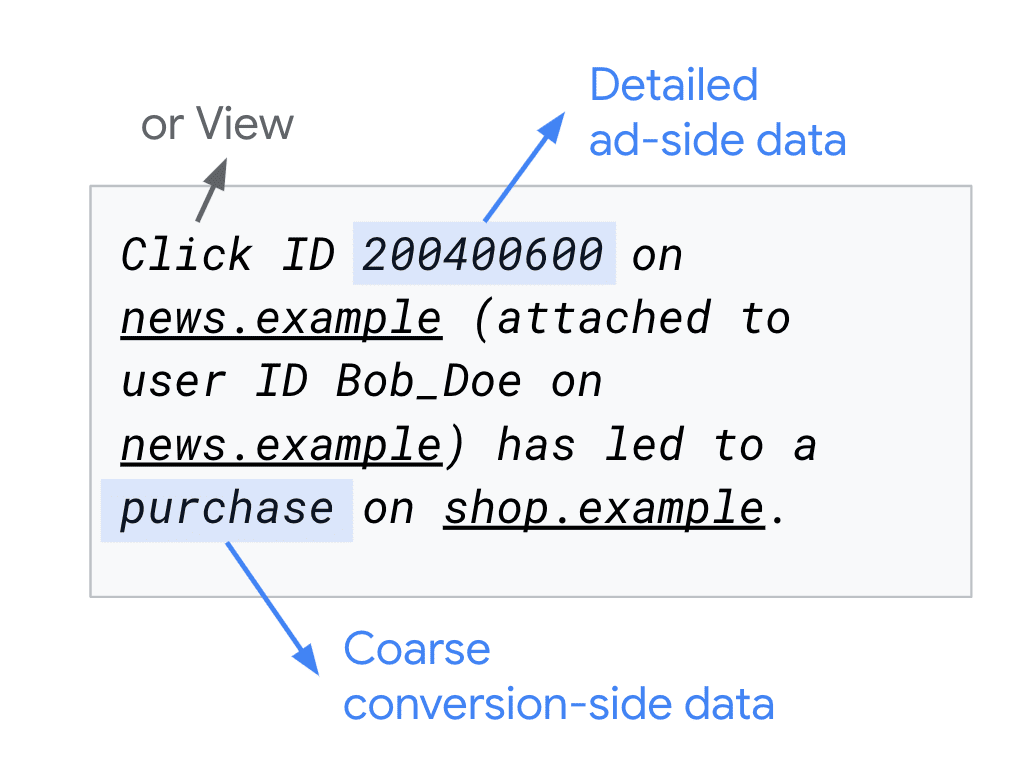
news.example (attached to user ID Bob_Doe on news.example) has led to a purchase on shop.example.Event-level reports are suited for:
- Optimization. Answer questions like "How can I improve my return on investment?". In particular, these reports can be used to optimize ad placement, as ad-side unique IDs can be made available in the reports. Event-level reports can provide training data for machine learning models.
- Coarse reporting, where very little information is needed about the conversion. The current limit is 3 bits of conversion data for clicks⏤this means a conversion can be assigned one of eight categories⏤and 1 bit for views. Encoding of granular conversion-side data, such as a specific price or conversion time is not supported in event-level reports.
- Fraud detection. The data in some reports can be useful for ad fraud detection and analysis, by allowing you to understand patterns that can be used to identify spammy or invalid activity.
Summary reports
Summary reports (formerly known as aggregate reports) offer more detailed conversion data and more flexibility for joining click or view data and conversion data.
Learn more about summary reports.
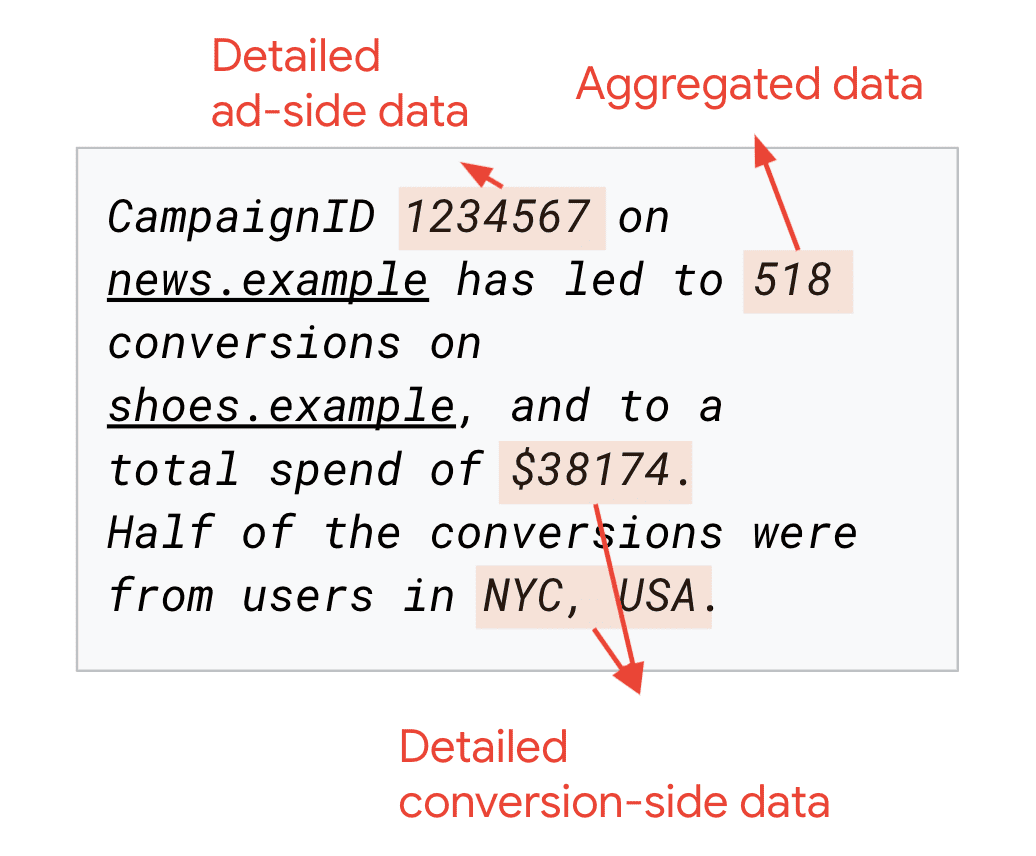
news.example has led to 518 conversions on shoes.example, and to a total spend of $38174. Half of the conversions were from users in NYC, USA.Summary reports are best suited for reporting use cases. These reports help answer questions such as: "What is my return on investment?"
Usage of summary reports for optimization—for example, to optimize for a purchase value, which is not supported by event-level reports (because the conversion data is too coarse)—is an area of active research.
Other features
Other features of this API include:
- App-to-web attribution: see or click an ad in an app and convert on the web.
Browser support
- Firefox and Edge haven't shared signals.
- Safari and Webkit is negative and proposed a different API to measure ad conversions, called Private Click Measurement.
Though the two APIs are different, Chrome and WebKit are working together in the open to simplify the developer experience, for example by aligning on the attribute names and on the JSON structure for reports.
The feature set of the Attribution Reporting API is different from that of the Private Click Measurement API proposed by Safari and WebKit. Most notably, with the Attribution Reporting API:
- View-through measurement is supported.
- Event-level reports can be provided.
- Summary reports contain rich information on both the click/view side and conversion side.
- Third parties such as ad tech platforms can receive reports on behalf of publishers and advertisers.
Browser configuration
- Users can opt out of the API with the user settings at
chrome://settings/adPrivacy. - The API is not active in Incognito mode.
- The API is not active when third-party cookies are disabled.
How can sites control access?
If the API is available in a given browser, it's available by default in any given site, both in top-level documents and scripts, and in same-origin iframes.
Arbitrary third-parties—for example, cross-origin ad iframes that were not added to the page with a script that has top-level access—can't use the API without a publisher's or advertiser's knowledge: in these iframes, the Attribution Reporting API needs to be explicitly enabled with Permissions policy.
<iframe src="..." allow="attribution-reporting"></iframe>
Third parties with top-level access that add cross-origin iframes to a page can also enable the Attribution Reporting API with Permissions policy.
A site can disable the Attribution Reporting API for all parties, including scripts with top-level access, by sending the HTTP response header:
Permissions-Policy: attribution-reporting=()
How does the Attribution Reporting API work?
The Attribution Reporting API enables measuring two events that are linked together: an event on a publisher's website, such as a user viewing or clicking an ad, with a subsequent conversion on an advertiser site.
Event-level reports

The browser matches clicks or views with conversion data defined by an ad tech.
Later, the browser sends the resulting reports to a predefined endpoint, with some delay and noise.
Summary reports
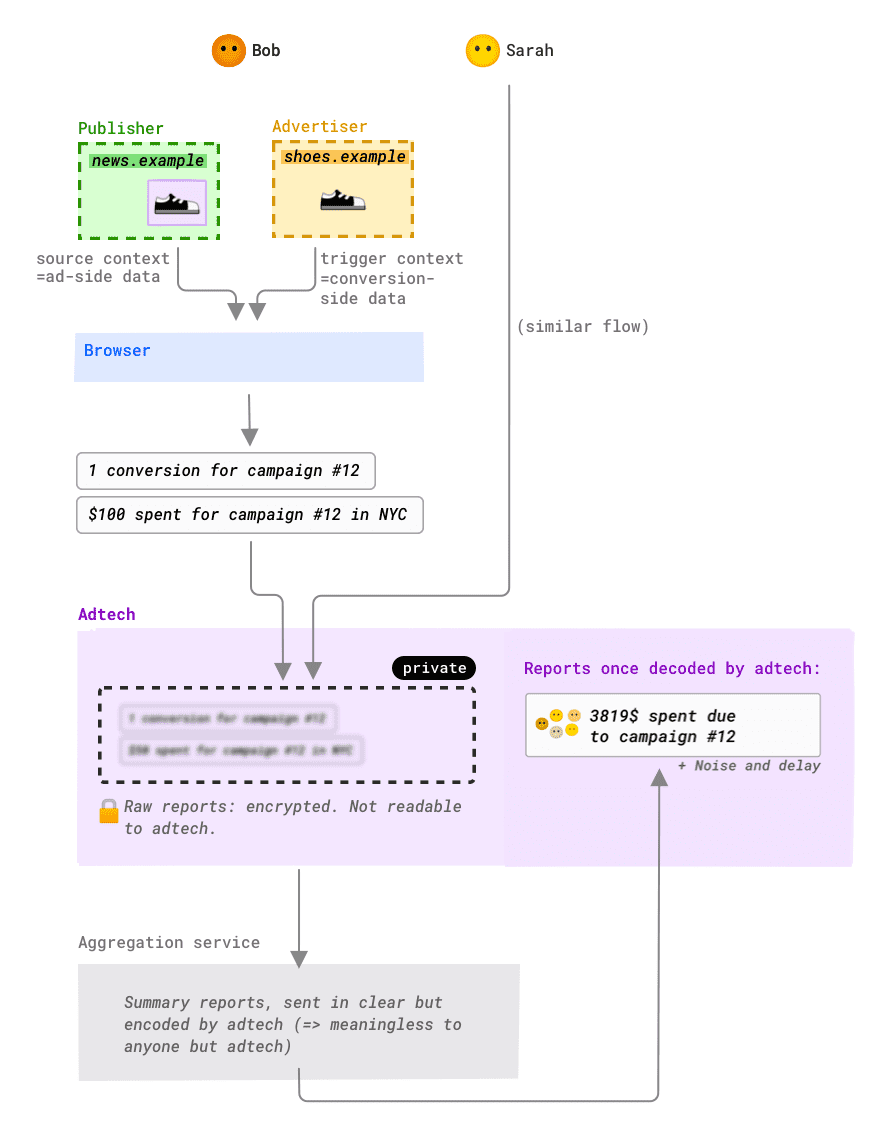
Summary reports are generated as follows:
- A user clicks or views a specially configured ad. The browser—on the user's local device—records this event, alongside pre-specified attribution configuration data.
- Later on, when the user converts, the browser matches this detailed click or view event (known as the attribution source event) with detailed conversion data (known as attribution trigger data). The dimensions of detail captured are pre-defined by an ad tech company, and the browser follows specific logic that is defined by the ad tech. The browser outputs this data in an aggregatable report.
- Aggregatable reports are encrypted by the browser and sent to an ad tech server. From the ad tech server, the aggregatable reports are sent to the aggregation service to produce a summary report.
- Summary reports are then made available to the ad tech. Note that summary reports are not delayed to the same extent as event-level reports.
Read more about summary reports.
Privacy
Unlike third-party cookies, the Attribution Reporting API allows advertising companies to gain insights into conversions without tracking an individual's activity across sites.
Let's take a person named Bob. Bob sees an ad while reading
the news on news.example. One week later, Bob buys shoes on
shoes.example.
Today, this conversion would be tracked by a third-party
cookie used as a cross-site identifier.
With third-party cookies, an ad tech company can access a lot
of details on Bob's activity on news.example and on
shoes.example. The ad tech can merge these pieces of
information together to build a detailed profile of Bob,
including Bob's location, browsing habits and
preferred reads on news.example. This profile could also
include purchases, activity, and credit card information on
shoes.example. This cross-site joint is useful to measure
ad conversions. But it hinders user privacy:
Bob's activity is tracked across sites with a high level of detail.
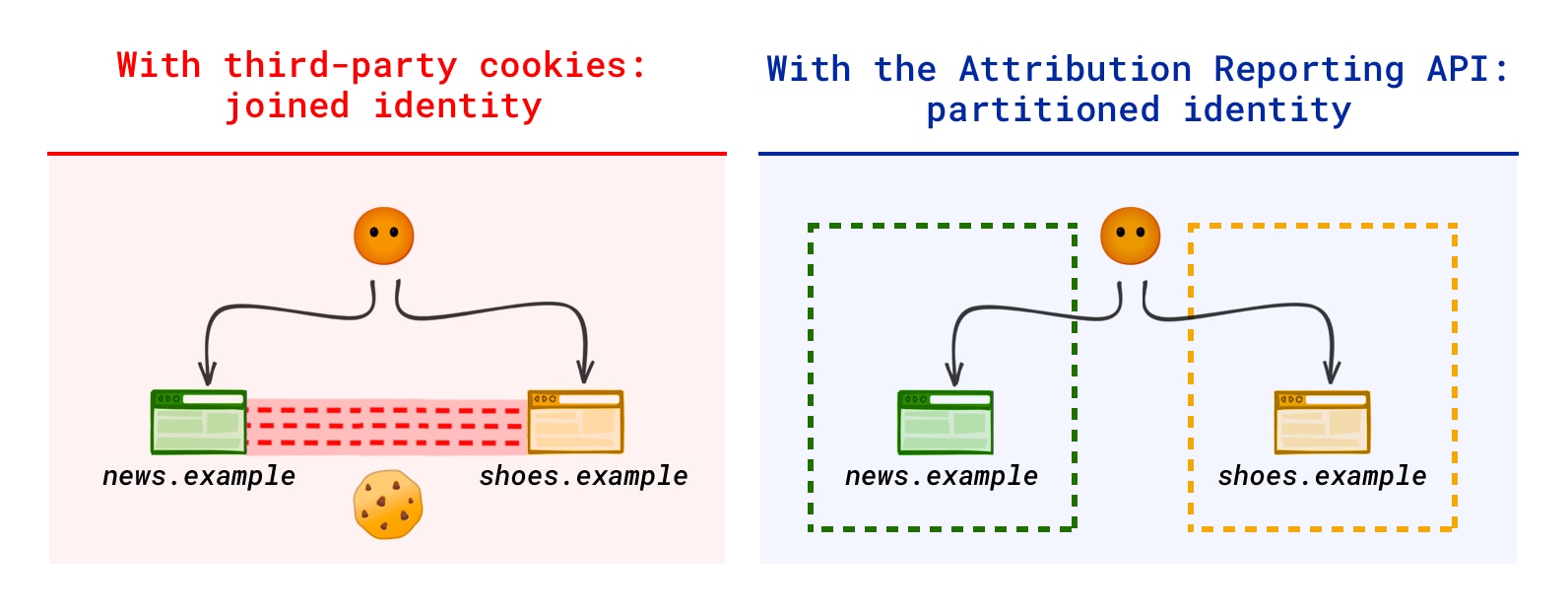
A small amount of information is joined
across sites—enough to measure conversions, but not
enough to track Bob's activity across sites in detail. Bob's
activity on news.example and on shoes.example remains
separate.
Protections in each report type
Event-level reports link an ad-side identifier with a small amount of conversion-side data. While they do provide cross-site information about a conversion, the conversion-side information is too coarse to join user identity across sites.
Summary reports provide detailed insights, but only at an aggregated level; because the contents of these aggregatable reports are encrypted when they are sent to the ad tech, the ad tech cannot get any information from the reports without using an aggregation service. The aggregation service only provides access to noisy aggregates.
Additional privacy protections such as rate limitations are imposed on both event-level and aggregate reports.
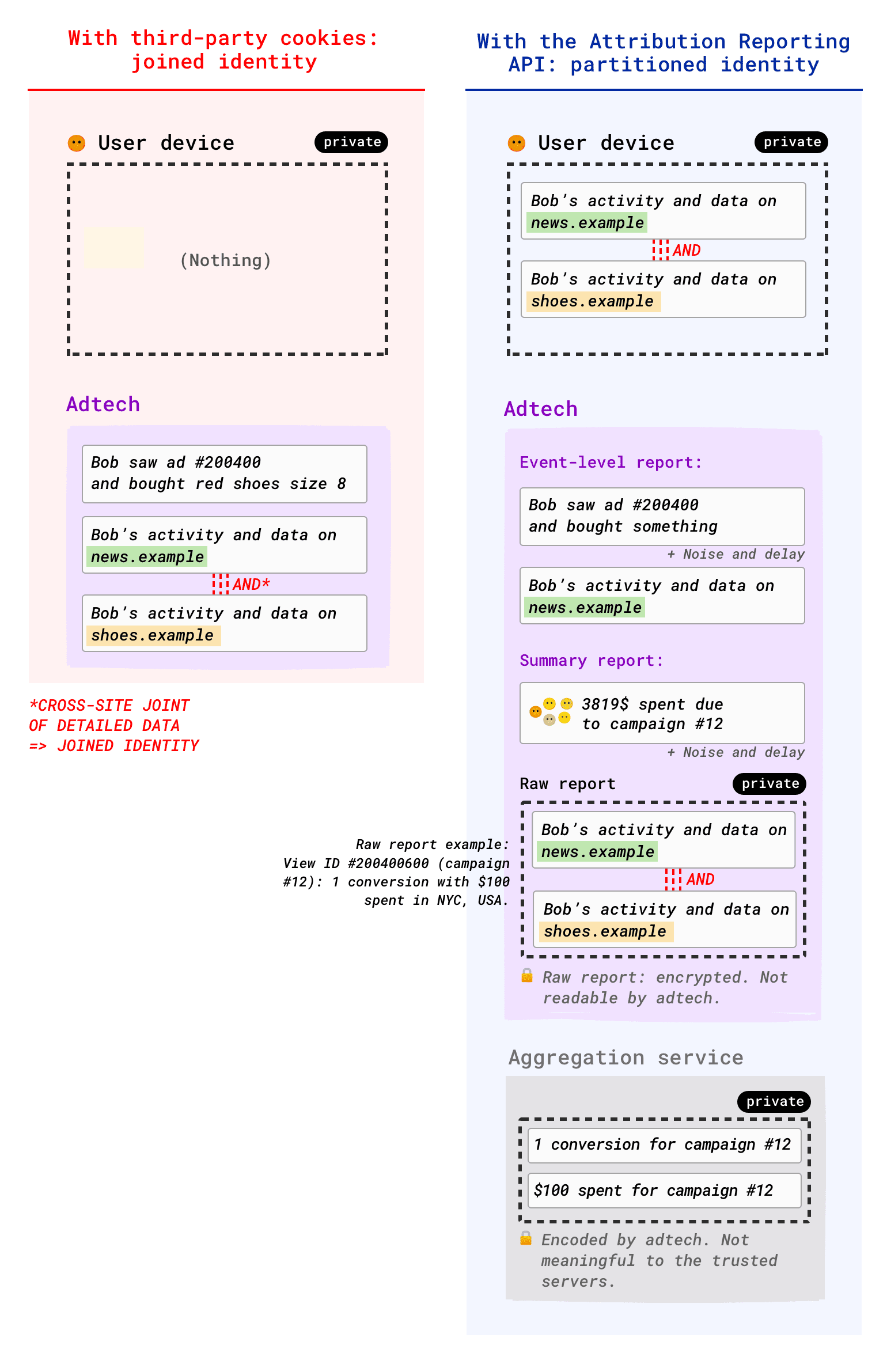
In detail: Event-level reports and privacy
Event-level reports provide conversion insights without tracking users across sites, by following the following privacy mechanisms:
- No cross-site identifier is used and no detailed cross-site browsing activity leaves the device.
- Event-level reports associate 64 bits of information on the ad side
(
news.example) with only 1 bit or 3 bits on the conversion side (shop.example). 64 bits are enough information to be mapped to an individual user identifier, but these 64 bits can only be linked with very little cross-site information: 1 bit or 3 bits, which are not enough to hold an identifier.- The ad-side 64 bits are not new information. A user ID can already be
available on the ad side today.
news.exampleoradtech.examplealready knows about a certain user's activity onnews.example.
- The ad-side 64 bits are not new information. A user ID can already be
available on the ad side today.
- Additional protections are applied to prevent abuse and cross-site tracking:
- The reports are sent with a delay.
- The conversion data is noised: a certain percentage of the time, fake reports are generated.
- The number of attributed conversion reports is limited per click or view.
In detail: Summary reports and privacy
Summary reports associate a click or view event with detailed conversion data. They provide conversion insights without tracking users across sites, by using the following privacy mechanisms:
- No cross-site identifier is used.
- Each attribution can make multiple contributions to a resulting summary report. Any given user can trigger multiple attributions for a particular click (or view) and conversion.
- Data is aggregated up to the level of many events (many users) and no individual events can be observed precisely. When looking at the aggregated data, as the level of detail increases so does the relative noise on that data increases as well. Slices of data that aggregate a lot of events and users are more accurate to preserve usefulness.
- The raw reports that associate a detailed click or view event with detailed conversion data are encrypted and not readable by the ad tech company. This data can only be read by the aggregation service.
- Additional protections are applied to prevent abuse and cross-site tracking:
- Reports are sent with random delays.
- Queries on different slices of the data are rate-limited.
Engage and share feedback
- For questions about the API: create an issue on the API repository.
- Follow API updates and announcements on the Attribution Reporting mailing list.
- If you have technical questions, file a Chromium bug.
- For implementation, integration, and general best practice questions: create an issue on the Privacy Sandbox developer support repository.
